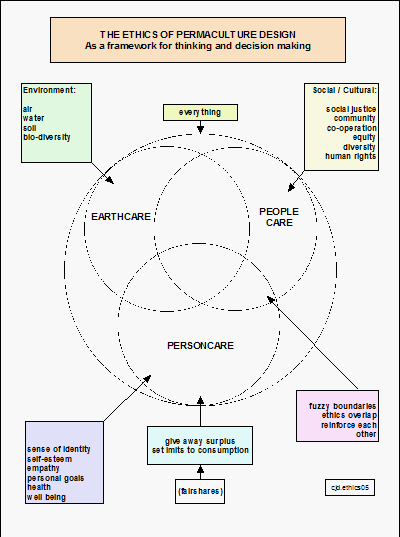Penrhos
Home Page![]()
![]() Site
Map
Site
Map ![]() Resources
Resources
back to my conributions to the British Permaculture Designers' Teachers' Handbook
ETHICS OF PERMACULTURE DESIGN:
Why I would include this subject.
Permaculture Design is unusual in that it contains and is built upon an agreed ethical framework. This makes it radically different from subjects such as organic gardening, alternative technology or agro-forestry where the ethos is implicit rather than explicit. Teaching the ethics provides one obvious way of drawing a distinction between Permaculture Design and other systems.
The ethics of Permaculture provide a useful entry into the understanding and design of holistic thinking and behaviour.
The ethics provide a guide in the form of directions to thinking and behaviour. As such they can be used as appropriate measures of the development of sustainable systems or as a reference system when choices of action are required.
Context.
I use the ethics as a valuable introduction to the course. As it requires examples, it can be used to suggest something of the inclusiveness of the subject as well as communicating the essential ethical basis to design.
Guide to session duration.
The initial introduction to the ethics can be quite brief, say 30 minutes. Successive subjects can then be related back to the ethics during the course, providing further understanding and applications. A longer session of say one hour can be included part way through the course to review their use and application. At the end of the course, participants can also be asked to swap time (2*2) on the question of how the course itself measured up to the ethics. The results can be fed back and collated during final circles as part of feedback.
How I teach this topic.
I introduce the ethics of Permaculture design as a "Pattern for holistic thinking".
I generate the pattern over the course of the session on a black or white board, drawing as much of the information and thinking as possible from the group.

I begin with the large circle which I call the whole system and then ask for the ethics and include them in their own separate but overlapping circles. I describe the boundaries between them as fuzzy. I ask for examples relating to each ethic and include them if the group agrees they are relevant. I also make sure the ones I consider of particular importance get in there (see pattern).
I use the version of the third ethic that appears in the Designer's Manual. I find this particularly useful as it can be used both at a personal level ( I, as a Permaculture designer, choose these limits for myself etc.) or at a national or even species level (we, as a country, choose not to use land mines etc.).
By being able to include the word Person in the inner group, along with Place and People, I can present the ethics as a very powerful design tool which provides us with the three main areas of attention required in effective, sustainable design.
I also mention modifications to the third ethic. For example, Peter Harper suggests "re-invest surplus" rather than "give away". Similarly, in the late 80's, the keyword "Fairshares" was coined as a replacement description. I describe a number of complications and possible challenges that may arise when using this latter term.
Link to principles.
I find it convenient to move from the ethics to an introduction to the principles. Practical examples of principles can be related back to the ethics.
Design exercises/group activities.
The session can be participatory. In later design exercises the ethical pattern can be referred to and used as a way of evaluating judgements.
Mind Map summary/flow chart
The pattern is the map of the session on the ethics.
Graphics
The graphics are the pattern of the map of the session on the ethics.
back to my conributions to the British Permaculture Designers' Teachers' Handbook